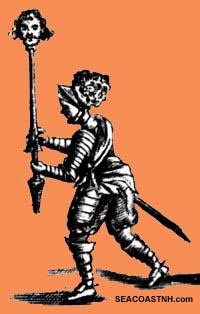|
FRESH STUFF DAILY |
|
|
||
|
|
||
|
|
||
|
SEE ALL SIGNED BOOKS by J. Dennis Robinson click here |
||
Page 1 of 3
After Jamestown and Pocahontas, Captain John Smith traveled along the American East Coast and coined the phrase "New England". He planned and almost pulled off a colony here. New Hampshire historians like to believe that Smith was headed back to the Piscataqua region or nearby when his colonial plans fell to pieces. Here is the story as we know it so far.
SEE: Photo History of Smith Monument in NH John Smith tried to start a colony here In history as in horseshoes "close" doesn't count. Still, now and then, someone tries so terribly hard to change the world, that it seems he should win an honorable mention. Take, for example, Captain John Smith, the man who gave New England its name. Long before the Pilgrims landed at Plymouth, Smith vowed he would start a colony here and he almost pulled it off. But failures, history insists, are doomed to a Purgatory of scholarly footnotes. Here is what happened to Smith's failed New England colony: Our story – the New England colony that failed – begins as Smith leaves Jamestown. In 1610, wounded and half-dead, Captain John Smith lay huddled below decks of a ship bound from Jamestown Colony back to England. After three years in the New World, his short term as "president" of America's first permanent settlement was already over. He would never see Virginia again, but by 1610 Smith had already carved one future notch in US history textbooks.
Even before Virginia, John Smith had been a soldier of fortune in the Mediterranean, then fought in a "holy" Christian crusade in Transylvania. There, according to his autobiography, he killed three Turkish warriors in single combat, lopping off their heads, which he displayed on pikes. Smith was wounded, captured, sold into slavery, freed by Princess Charatza Tragabigzanda, then was tossed into another prison by her brother. This time he escaped by murdering his captor with a cudgel and traveling, penniless and on foot through Russia and Poland, where he was wounded, to finally rejoin his troops. After his bloody Crusade, Smith returned to England via Africa, got bored, signed on for Virginia and made his mark on American history. That brings us right back to 1610 when we find Smith, at the ripe old age of 29, still battling the severe burns he received in an explosion at Jamestown. He had been done in, not by a ferocious enemy, but by the spark from a comrade's tobacco pipe that ignited Smith's gunpowder bag as he slept. Impoverished again, unable even to walk Smith languished two months at sea, then lay months longer in a cheap London room, depressed, seeing no one but the doctor who came each day to dress his wounds. CONTINUE to read the CAPTAIN JOHN SMITH
Please visit these SeacoastNH.com ad partners.
News about Portsmouth from Fosters.com |
| Tuesday, April 16, 2024 |


|
Copyright ® 1996-2020 SeacoastNH.com. All rights reserved. Privacy Statement
Site maintained by ad-cetera graphics

 Link Free or Die
Link Free or Die




 He had already saved the fledgling colony, explored the Potomac River, and had his famous encounter with Native American "princess" Pocahontas. While in Virginia, always prone to speaking his mind despite the consequences, Smith was thrown into prison, sentenced to death by Jamestown leaders and nearly killed in multiple Indian attacks.
He had already saved the fledgling colony, explored the Potomac River, and had his famous encounter with Native American "princess" Pocahontas. While in Virginia, always prone to speaking his mind despite the consequences, Smith was thrown into prison, sentenced to death by Jamestown leaders and nearly killed in multiple Indian attacks.














